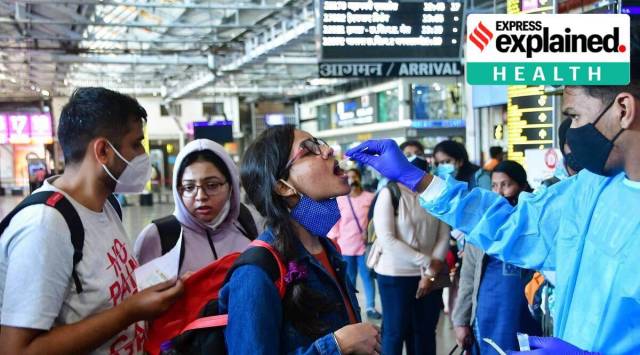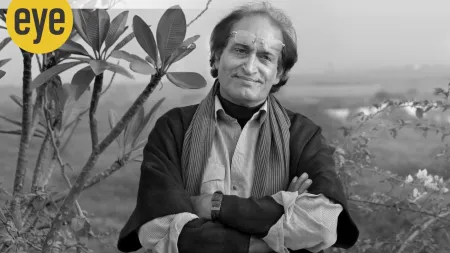- India
- International
Covid-19 cases rising: here’s what you need to know
What do the current data on Covid-19 show? Is the infection more widespread than the official figures suggest? Which variant of the virus is driving the current surge?
 Testing for Covid-19 at an airport. (File Photo)
Testing for Covid-19 at an airport. (File Photo)Anecdotal evidence has been increasing about a new spread of coronavirus infections — more people seem to be falling sick with Covid-19 than in the recent past. However, almost no one is ending up in hospital.
What do the current data on Covid-19 show?
There are four significant trends.
One, there has been no exponential rise in the active cases trajectory. On Friday, the number stood at 1,01,830 cases; this is slightly lower than the previous two weeks — active cases were at 1,23,535 on August 12, and 1,35,364 on August 5.
Two, the weekly positivity rate has not increased. On Friday, the weekly positivity rate stood at 3.90% compared to 4.88% reported last Friday (August 12).
Three, granular data being analysed by the Health Ministry show that in the first week of August, 144 districts reported positivity of more than 10%, indicating potential for the virus to spread to other parts of the country. The nine districts of Delhi, neighbouring Gautam Budh Nagar, Kolkata, and Pune were among the large urban clusters reporting more than 10% positivity. Mumbai has seen a bump in cases over the last three days, and test positivity touched 10.3% on Thursday.

Four, even though urban clusters have seen a case bump, testing levels nationally have remained at the same level for the past two weeks. During August 13-19, India conducted 23.35 lakh tests; this number was 23.76 lakh during August 6-12. More significantly, granular data for the first week of August show as many as 423 districts were reporting test positivity rates below 5%; however, a very large number of tests were Rapid Antigen Tests. In order to understand the real spread of the infection, it is essential that both the testing rate and RT-PCR testing, considered the gold standard, are increased.
Is the infection more widespread than the official figures suggest?
Clinicians say the spread of infection is much higher than the current positivity rate. “In Delhi, there is definitely a surge, almost like a fourth wave. This is in spite of the fact that people are not testing much. Many think they have caught only a flu. But most people whom I am recommending test, are returning a positive result,” Dr Suranjit Chatterjee, Senior Consultant, Internal Medicine, Indraprastha Apollo Hospitals, said.
Dr Chatterjee said that while fever is a very important criterion, even without fever, patients with a sore throat, body ache, and headache are testing positive. “I would expect that the numbers are much higher than what we are quoting right now. Patients aren’t testing, and doctors are not asking enough patients to get tested,” Dr Chatterjee said.
Is the surge overwhelming health systems?
Not yet. Dr Chatterjee said that in the current surge, fever is of a higher degree for the first few days. “Beyond that, the fever is resolving in 3-5 days in most cases. That is why most people are taking it as a simple viral fever. Even in the comorbid, it is largely a mild disease. Hospitalisation is more only because the number of cases is more. In terms of percentage, severe disease is not higher. Mortality is also happening in comorbid patients and vulnerable age groups,” he said.
Dr Chatterjee, however, cautioned that the highly infectious variants of Omicron have significant immune escape properties, and the rise in case numbers should not be taken lightly. “We are seeing patients who have taken booster (third) doses getting infected. I’m seeing that people who have been naturally infected are slightly better protected. At the same time, I have seen people who were infected two months back getting reinfected again. Therefore, Covid-19 appropriate behaviour is essential,” he said.
Which variant of the virus is driving the current surge?
According to INSACOG, the network of Indian research labs sequencing the genome of the virus, the percentage lineage frequency of BA.2.75 for August stood at 60.7%, compared with just 20.6% in the previous month, indicating that this new sub-variant of Omicron is driving the surge in the country.
According to the data, the percentage lineage frequency of BA.2.75 in North India for August was at a significant 88.2%.
According to the WHO, this variant has nine additional mutations in the spike compared to its parent lineage BA.2; four of these mutations are within the receptor binding domain (RBD), and at least one of these RBD mutations has been associated with immune escape in previous variants. Most significantly, the WHO has said that the majority of the reported sequences are from India.
What is the government doing about the potential surge in cases?
The Centre has specifically flagged to the states the districts that are witnessing high average daily cases and an increase in the weekly positivity rate. It has told the states that “consistent increase” brings to the fore the need for heightened action at the local level to contain the spread of infection.
The coming months are likely to witness mass gatherings for various festivities across the country, and a large number of people are expected to travel to attend these gatherings. “This may potentially felicitate transmission of Covid-19,” the states have been told.
Also, the Centre has asked the states to report influenza-like illnesses and severe acute respiratory infection (SARI) cases on a regular basis in order to detect early warning signals of the spread of infection.
More Explained
EXPRESS OPINION
May 05: Latest News
- 01
- 02
- 03
- 04
- 05







































